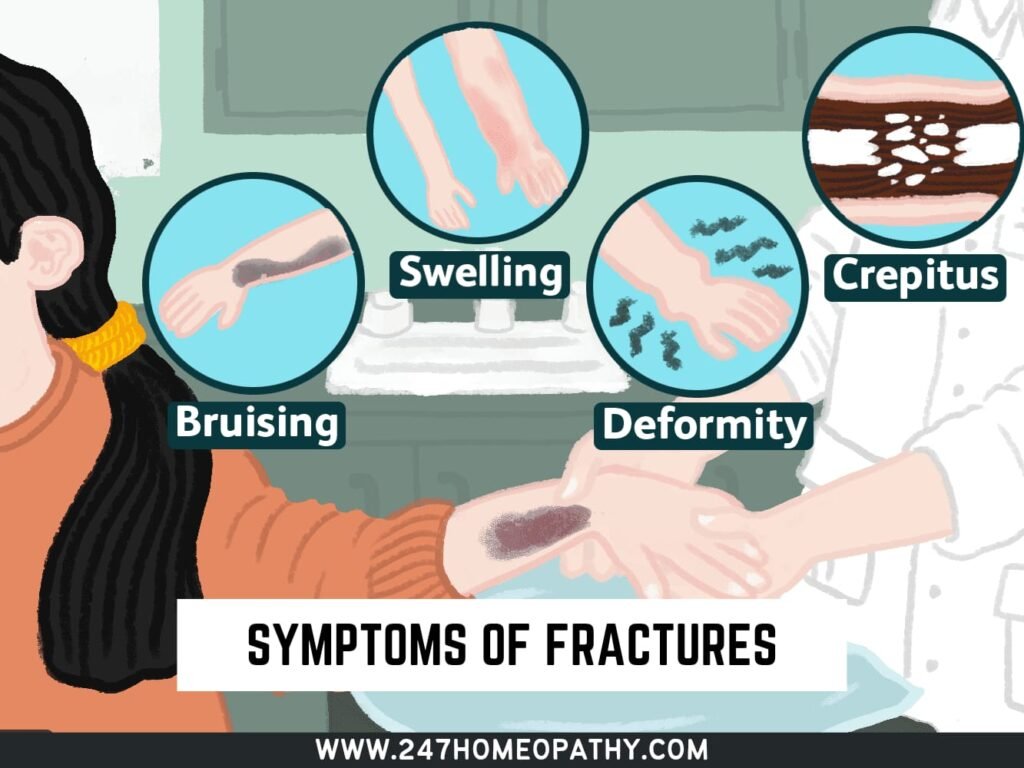
Fractures
A broken bone is known as a fracture. There are many possible causes of fractures, the most common cause is fall or accidents.
There are other causes too like osteoporosis (bones become weak and brittle), osteogenesis imperfecta (brittle bone disease) or some cancers that can cause breaks in the discontinuity of the bone and are termed pathologic fracture.
Causes:

The fracture can occur due to fall or accidents.
Repetitive use of a single muscle or single body part can cause stress over the body that leads to weakened muscle or bones that may cause a stress fracture. It mainly occurs in sports players or athletes
Some disease conditions like osteoporosis, osteogenesis imperfecta or tumors make bone so weak and fragile even that small stress over the bone can cause a fracture or small crack in the bone.
Trauma
Direct strike over the body part
Types of fracture:
Closed fracture: if an injury is not breaking off the skin open is called a close fracture.
Open fracture: if an injury breaks off the skin completely where we can see a bone or other tissues is called an open fracture.
Complete fracture: when a bone breaks down into two separate pieces called a complete fracture.
Displaced fracture: when a bone breaks down into one or more pieces and moves out of its alignment called a displaced fracture. A displaced fracture requires open surgery to fix the bone into its alignment so it will heal properly. This is called a reduction.
Partial fracture: when the bone doesn’t break off into two pieces or crack doesn’t reach across the entire width of the bone called a partial fracture.
Avulsion: avulsion fracture is where a piece of bone attached to tendons and ligaments is pulled away from its location called an avulsion fracture.
Community fracture: when a bone breaks off into small multiple fragments called community fracture.
Oblique fracture: oblique fractures occur diagonally to the length of the bone.
9. Spiral fracture: spiral fracture occurs when a part of the bone is twisted away causing the fracture.
10. Hairline fracture: a small crack in the bone that may get unnoticed called hairline fracture.
Symptoms of fracture:
Visible deformity of the bone. Unbearable pain
Swelling
Bruises over the affected part Unable to use affected part
Muscle spasm
Hematoma
Inflammation of the affected part Open wound
Complications of fracture:
The fracture may take a longer time to heal Septic or neurogenic shock
Gas gangrene
Tetanus
Visceral injury Vascular injury Nerve injury
Infection
Muscle stiffness or contracture
Diagnosis:
Imaging tests like x-ray, CT scan, MRI are helpful to see the condition of bones.
Bone scan: bone scan helps where fracture didn’t show up in the x-ray.
Homoeopathy medicine:
Symphytum: Symphytum is well-indicated medicine for fractures. It can be given in a comminuted fracture. It accelerates the healing process by increased formation of the callus. Fracture of periosteum or injury to the shin bone. Brittle bones.
Calcarea Phos: Calcarea phos has marked action on a broken bone or delayed healing of broken bones. Gnawing pain in the affected part of the body.
Arnica: Arnica is well-indicated medicine for mechanical injury, where it reduces the swelling, pain, soreness around the affected part. It helps to calm the patient and reduces the risk of shock that may occur due to fracture.
Calendula: calendula has excellent results in open fracture, where the skin breaks off and is prone to infection due to exposure to the external environment. It helps in the healing of wounds.